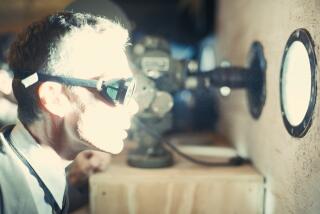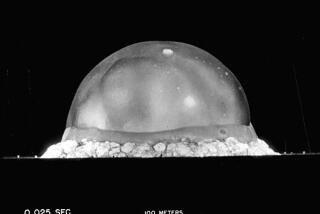Ray Crist, 105; Chemist Helped Develop Atomic Bomb
- Share via
Ray Crist, a chemist who helped produce the atomic bomb as a member of the Manhattan Project but later turned to environmental science and researched ways to remove toxic metals from water and soil, died Monday. He was 105.
Crist died at a nursing home in Carlisle, Pa., after suffering a stroke, his son, Henry Crist, said Tuesday. He had been a longtime resident of Carlisle.
Raised on a farm in western Pennsylvania, Crist graduated from Dickinson College in Carlisle and earned a doctorate in chemistry at Columbia University in 1925.
His first job was as a chemistry teacher and researcher at Columbia. In 1941 he joined the Manhattan Project, which was based at the university during the early research stages, and helped develop the atomic bomb. He worked with other scientists, separating the uranium isotopes needed to help detonate the bomb.
“You do what you have to do to survive and for your country to stay alive,” Crist later said. He added, speaking for himself and his colleagues at Columbia, “But we were very unhappy about what we were doing.”
He said that when he learned that the bomb had been dropped on Hiroshima and Nagasaki in 1945, he felt responsible.
In 1946 Crist left Columbia to be a researcher for Union Carbide Corp., first as the manager of the Coal Hydrogenation Plant in Charleston, W.Va., and later as director of research in Tarrytown, N.Y.
“My father became concerned about the negative effects of science and technology on the environment and on society,” Henry Crist told The Times on Tuesday.
Crist retired from the corporate sector at 63 and returned to teaching with the goal of educating liberal arts students about science.
“He wanted future lawyers, politicians and other leaders of society to understand the impact of science and technology on our environment,” his son said.
At Dickinson College, where he taught until age 70, and later at Messiah College in Grantham, Pa., Crist was a volunteer professor earning $1 per year, which was “adequate to my needs,” he said.
At age 102, he was named “America’s Oldest Worker” by Experience Works, a nonprofit provider of training and employment services for older workers.
For some years he concentrated on laboratory research at Messiah College and wrote more than 20 papers. Many of them were on bioremediation, a process of removing metal contaminants from water and soil using plant material. His papers were presented at conferences in Asia, Scandinavia, Europe and the U.S.
“Having seen how chemical companies work, Ray Crist wanted to help clean up the environment,” said Karl Oberholser, a fellow chemist at Messiah College.
At 102, Crist still waded into a stream to collect the algae he used for his research. He retired from Messiah College at 104.
His early life on the family farm, working outdoors for hours every day, made him a nature lover at a young age. “Nature has been my greatest teacher,” he said in “The Living Century,” a 2001 series that aired on PBS.
He married Dorothy Lenhart in 1925. The couple had three children, including twin boys, Henry and DeLanson, and an adopted son, Robert.
Dorothy Crist died in 1962. Recalling the loss for “The Living Century” close to 40 years later, Crist’s eyes filled with tears. “This is permanent with me,” he said. “I never, ever talk about Dorothy.”
He attributed his own long and active life to his inherent curiosity. “In all that I have done, this matter of trying to imagine how things are functioning is what moves me,” he said in a 2002 interview with the “CBS Sunday Morning” show.
Crist’s memoir, “Listening to Nature: My Century in Science,” was published this year.
He is survived by his sons, nine grandchildren and 15 great-grandchildren.
More to Read
Sign up for Essential California
The most important California stories and recommendations in your inbox every morning.
You may occasionally receive promotional content from the Los Angeles Times.













